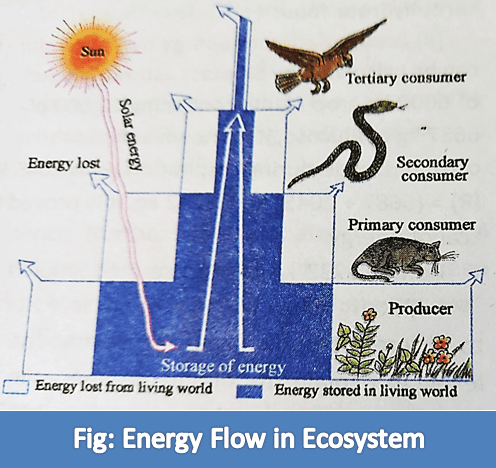Energy Flow:
The process by which the solar energy is trapped by producers and modified solar energy is passed through different trophic levels of the food chain is called energy flow.
All organisms require energy for their growth, reproduction, and various metabolic activities. Sun is the ultimate source of energy used by the living world. Producers trap solar energy and convert it into chemical energy held in the bonds of organic compounds synthesized by them. They can utilize only 1-3% of incident light energy and the rest is dissipated as heat.

The energy of the sunlight can be transformed into the energy of food and heat according to first law of thermodynamics. The total energy which is present in the food is termed gross production. The energy stored by plants is passed through primary consumers, secondary consumers, and tertiary consumers. A large proportion (80-90% of potential energy) is lost due to the production of heat and work done by the body.
According to the second law of thermodynamics, while energy is transformed from one form to another, a decrease in the amount of utilizable energy takes place. Thus, the transfer of chemical energy from one organism to another leads to the degradation and loss of a major fraction of this energy as heat due to metabolic activities. Only a small fraction is stored within the living tissues.
Stages of Energy Flow:
i. Fixation of energy by producers: Amount of incident solar energy on the earth’s surface is nearly about 12.3 x 1022 calories per year. According to scientist Rudolf Geiger near about 42% of this energy. This energy is reflected back due to the presence of dust particles, clouds, smoke, etc. 10% of solar energy is absorbed by suspended solid particles in the air. 48% of solar energy falls on the earth’s surface. Some of this light energy is also reflected from the earth’s surface. The chlorophyll of green plants captures the remaining light energy for photosynthesis. With this energy and chlorophyll green plants produce carbohydrate food.
ii. Accumulated energy by the producers: The energy accumulated by the producers can be calculated by biomass estimation. According to scientist Edger Transeau, a total weight of 6000 kg crop plants containing 10000 plants which can assimilate 2675 kg of carbon, i.e, 6687 kg of glucose, is known as Net Production (NP).
iii. Energy flow from producer to successive trophic levels: Energy flows from producer to different trophic levels. Some amount of energy is lost as heat energy at each trophic level. According to Raynold Lindemann formulated “the ten percent law“, “each organism at a trophic level can only utilize 1/10 th of the total food consumed”.